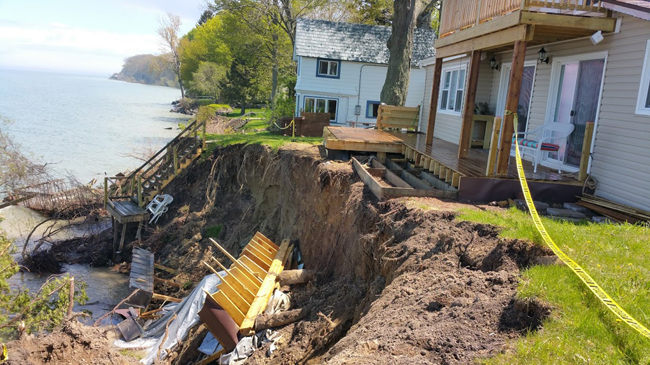
High water erosion, June 2017, at Hamlin, NY. Credit: Mary Austerman/New York Sea Grant
Contacts:
Mary Austerman, Great Lakes Coastal Community Development Specialist, New York Sea Grant, P: 315-331-8415, E:mp357@cornell.edu
Kara Lynn Dunn, Publicist, P: 315-465-7578, E: karalynn@gisco.net
Newark, N.Y., April 27, 2018 - Survey data results and photos, public testimony, and resources related to the 2017 Lake Ontario record high water level event are now on the New York Sea Grant Web site at www.nyseagrant.org/waterlevel2017.
The site includes:
- New York Sea Grant testimony given by NYSG Coastal Community Development Specialist Mary Austerman at two public hearings: October 2017 and at November 2017.
- results (spreadsheet format) from the New York Sea Grant-Cornell University 2017 high water survey
- a presentation of results from the New York Sea Grant-Cornell University 2017 high water survey of Lake Ontario property owners
- a clickable story map with aerial photos and text descriptions during high water level in June 2017 at locations from Braddock Bay in Monroe County to Stony Creek in Jefferson County
- a Photo Gallery of high water impact images
- audio and video reporting on the flooding event; Also, there's video and presentation from a September 2017 mold remediation workshop
New York Sea Grant partnered with Dr. Scott Steinschneider and Dr. Richard Stedman at Cornell University to develop and implement the 2017 high water level impact survey to document the parcel-level impacts of the event on waterfront properties, identify areas most vulnerable to future flooding, and verify existing flood-risk modeling.
Data results from the summary of 490 validated high water survey responses by Lake Ontario property owners in New York include:
- 97% reporting nearshore inundation, 68%: outbuilding inundation; over 60% inundation of foundation and-or main structure first floor
- 82% reporting not having flood insurance
- 70% reporting some level of erosional damage to nearshore areas; 44% to outbuildings: 25% to main structure
- 49% reporting moderate to severe land loss to erosion
- 58% reporting moderate to severe damage to shoreline protection, i.e., vertical or sloping wall
- 61% reporting an overall impact of 7-10 with 1 as no impact, 10 severe
In a separate project, environmental consultants Thomas Hart and
Geoffrey Steadman developed the story map with aerial photos providing a
visual tour of high water impact along the Lake Ontario shoreline near
peak water levels in June 2017. New York Sea Grant provided funding in
part for the aerial photography.
New York Sea Grant provided materials to assist an online survey initiated in November 2017 by Conservation Ontario on behalf of the Great Lakes-St. Lawrence River Adaptive Management Committee, and open to Lake Ontario and St. Lawrence River shoreline property owners in Canada and New York.
More Info: New York Sea Grant
New York Sea Grant (NYSG), a cooperative program of Cornell University
and the State University of New York (SUNY), is one of 33 university-based
programs under the National Oceanic and Atmospheric Administration’s
National Sea Grant College Program.
Since 1971, NYSG has represented a statewide network of integrated
research, education and extension services promoting coastal community
economic vitality, environmental sustainability and citizen awareness
and understanding about the State’s marine and Great Lakes resources.
Through NYSG’s efforts, the combined talents of university scientists
and extension specialists help develop and transfer science-based
information to many coastal user groups—businesses and industries,
federal, state and local government decision-makers and agency managers,
educators, the media and the interested public.
The program maintains Great Lakes offices at Cornell University, SUNY
Buffalo, SUNY Oswego and the Wayne County Cooperative Extension office
in Newark. In the State's marine waters, NYSG has offices at Stony Brook
University in Long Island, Brooklyn College and Cornell Cooperative
Extension in NYC and Kingston in the Hudson Valley.
For updates on Sea Grant activities: www.nyseagrant.org has RSS, Facebook, Twitter, and YouTube links. NYSG produces a monthly e-newsletter, "NOAA Sea Grant's Social Media Review," via its blog, www.nyseagrant.org/blog. Our program also offers a free e-list sign up via www.nyseagrant.org/nycoastlines for its flagship publication, NY Coastlines/Currents, which is published quarterly.